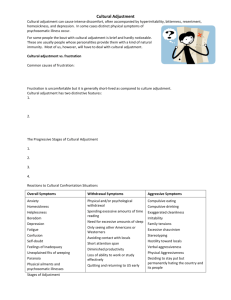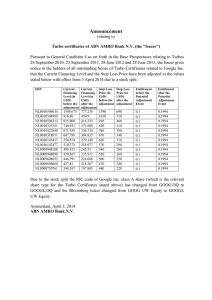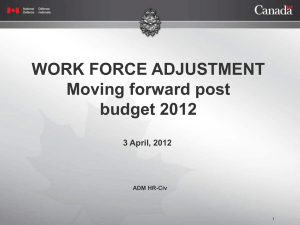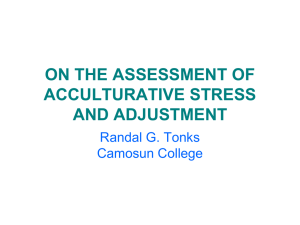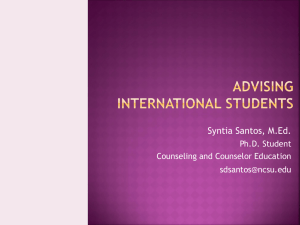Transfergalicious Improving transfer student adjustment at
advertisement
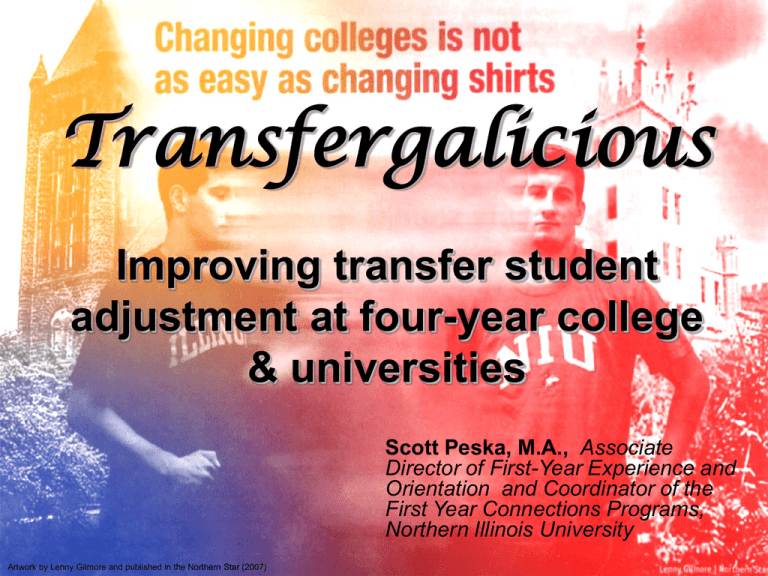
Transfergalicious Improving transfer student adjustment at four-year college & universities Scott Peska, M.A., Associate Director of First-Year Experience and Orientation and Coordinator of the First Year Connections Programs, Northern Illinois University Artwork by Lenny Gilmore and published in the Northern Star (2007) Presentation Outline • • • • Introduction Review of Literature Best practices Discussion •Associate Director Orientation & First-Year Experience at NIU •UNIV 201: Transfer Experience seminar instructor •Doctoral student researching transfer student adjustment •Community college transfer student Fergalicious Fergalicious – adjective Meaning: Fergie, a contemporary musical artist (formerly with the Black-Eyed Peas) is so attractive that she drives men crazy (i.e., “make them boys go loco.”) Derived from combining her name with delicious Transfergalicious Transfergalicious – adjective Meaning: transfer students are such an attractive population that institutions are expanding programs to increase their number of transfer students and help them adjust to campus. Northern Illinois University • Four-year, public, comprehensive, doctoralextensive institution located 60 miles west of Chicago • 18,600 undergraduates (3,200 freshmen, 3,100-3,200 transfers) • 75 percent of transfers come from Illinois public community colleges • Majority (60 percent) of juniors and seniors are transfers • Transfer Center developed within past five years • New office for Commuting and NonTraditional Students established 2005 • Mandatory 1-day transfer orientation Review of Literature • How do we define transfer? • Who are considered transfer students? • Transfer student adjustment Transfer Definitions – Are individuals who transfer fewer than 12 credits to be considered transfer students? – Are students that are co-enrolled and transferring their hours considered transfer students? – Are students who are leave, attend elsewhere, and return an institution considered transfer students? – Is someone who attended a different institution 15-20 years ago and transferring those credits considered a transfer student? – How about a student who has 219 credits and is entering to gain a teacher certificate? Types of Transfer • Vertical (2-4) Two-year to four-year institutions • Horizontal (2-2; 4-4) Two-year to two-year or four-year to four-year • Reverse (4-2) Four-year to two-year • Gypsy/Multiple (?-?-?) Attending more than two institutions (Jacobs, 2004) Transfer Definitions • McCormick and Carroll (1997) “Transfer can be defined as a transition between post-secondary institutions, in which the second institution (the receiving institution) grants the student credit for coursework taken at the first institution (the sending institution)” (p.1). Transfer Definitions Townsend (2002) investigates numerous transfer rate studies and claims, “the major difficulty in determining transfer rates is deciding which students are to be included” (p.15). Characteristics of Transfer Students • “Number & Variety” – commonly used to describe community college students (Cohen & Brawer, 2003) • Fredrickson (1998) reported on more than 4,700 that the typical (mean) transfer student was – Employed part-time – 26 years of age – Female Characteristics of Transfer Students • Grubb (1991) reported that a considerable number of minority students who receive a baccalaureate degree started at two-year institutions • Cohen and Brawer (2003) suggest that the students least likely to transfer are adult students that attend community colleges part-time Characteristics of Transfer Students • In their NCES national study based on longitudinal data, Peter and Cataldi (2005) found that nearly twice as many younger, dependent, traditional-age students (58%) attended more than one institution compared to independent, non-traditional students (27%). California State University, Chico Web Site (2008) Characteristics of Transfer Students • Eggelston and Laanan (2001) reported that nearly 50% of community college transfer students are from CTE programs. • Many community college students transfer prior to earning an associates degree (Cohen & Brawer, 2003; Dougherty, 1992; McCormick & Carroll, 1997; Townsend and Ignash, 2000). Transfer Student Adjustment • Laanan (2001) states “student transferring from one institution to another is going to experience some form of adjustment” • Community college students transferring to a four-year institution have been well documented that they may experience a number of academic and social adjustment challenges (Berger & Malaney, 2003; Britt & Hirt 1999; Cedja, 1994; 1997; Diaz, 1992; Graham & Hughes, 1994; House 1989; House & Keely 1993; Laanan 1996; 1998; 2001; 2004; Townsend, 1993; 1995; Townsend & Wilson, 2006). Transfer Student Adjustment • Steinmann, Pope, and Miller (2004) analyzed academic research journals and found that the majority of studies on the transfer process were quantitative with a focus on academic challenges • “The drop out rate is high [for community college students] and for students who decide to transfer to senior institutions, they experience a difficult adjustment process” (Laanan, 2003 p. 498) Transfer Student Adjustment • Most common discussed is Hill’s (1965) findings of “Transfer shock” (dip in GPA in first semester after transfer) •Diaz’s (1992) meta-analysis of studies investigating transfer shock found that 79 percent of the studies indicated a relatively low magnitude of half a point or less experienced and that 67% recovered their GPA usually at the end of their first year. Westmont College Admissions Web site (2008) Transfer Student Adjustment Townsend (1995) interviewed 24 transfer students (16 who left the university) and found: – Transfer students described the university as having higher academic standards – That they felt unprepared to attend the university – Transfer students perceived the university as a competitive environment – That transfer students needed to be more self-reliant – They perceived freshmen to be more prepared and serious than community college transfers students Transfer Student Adjustment Bauer & Bauer (1994) surveyed 92 community college transfer students and reported: • Nearly 33 percent experienced difficulty with making friends at the university • 31 percent shared they struggled to meet new people • 30 percent reported personal self confidence issues after transferring and had difficulty “fitting in” Transfer Student Adjustment Keup (2006) found that 61 percent of 1,140 transfer student respondents rated themselves as “above average” among their peers in their social self-confidence. Gumm (2006) found that the community college transfer student’s interaction with peers was a high social predictor of transfer students persisting the following semester Transfer Student Adjustment Britt & Hirt (1999) Conducted group interviews with 25 students and interviews with 16 administrators – They found that participants reported feeling isolated and found the most difficult part of their adjustment to the institution was in making friends – The administrators believed this was in part due to the lack of institutional resources available to students in the spring Transfer Student Adjustment Smith’s (1999) dissertation study investigated the concept of mattering through perceptions of 161 community college transfer students and found: •That nearly one third of the participants perceived that they did not matter to the university (compared to the community college) •They found the university to be less student-centered than the community college. Transfer Student Adjustment Nowak (2004) interviewed 23 community college transfer students and eight faculty and found: – That often the four-year institution made assumptions that students transferring from community colleges had similar experiences, when in fact community colleges are vastly different. – Perceived that they had to search things out on their own at the university and did not feel that they knew many people on campus What we can, should, and need to do! Best Practices Best Practices Transfer FIGS – University of Oregon • Transfer First-Year Interest Groups are designed for transfer students with major or pre-major status, but open to all transfers • Transfer FIGs are promoted during orientation. • Transfer FIGs have a transfer student Teaching Assistant to help address the unique needs of trans transitioning to campus. Best Practices Transfer mentor/Ambassadors - University of North Texas • Transfer Ambassador Program connects new transfer students with current UNT transfer students. • Transfer Ambassadors attend transfer orientation sessions and help personally mentor new transfer students • Transfer Ambassadors participate in a "Transfer Panel" to answer questions at orientation. Best Practices Transfer Seminars • Radford University – UNIV 100-T – Transfer student academic transcript evaluation – Getting involved • NIU – UNIV 201 –Transfer Transition course – 1 –credit, 12-week graded course – Extended orientation – academic & social aspects of the community Best Practices Orientation options - University of Utah • A 3-hour transfer orientation • A 6-hour comprehensive transfer orientation • An overnight transfer orientation • A combined (freshmen & transfer) orientation • Mini orientations (during the first day of classes) Best Practices Welcome Week Events • Transfer small group meeting – opening night • Transfer Student Cookout • Transfer student Academic Success/involvement seminars • Transfer student social dinner Best Practices Transfer Student Organizations • Tau Sigma – 50 chapters nationwide – 14 Scholarships of $500 to $2,500 • Transfer Student Associations – Transfer student BBQ – Open house and transfer days Best Practices Brochures - University of Michigan • Downloadable (PDF) Transfer Brochure -for each term (summer, fall, winter, & spring) • Includes: – – – – – – – Overview of the day Important dates / Academic calendar Registration information Traveling to campus information FAQs Important Contacts (phone numbers & Web pages) How to access an online checklist of what students need to do before arriving on campus Best Practices Web Resources - Use and promote national, regional, and state online resources • http://www.collegetoolkit.com/Guides/Transfer/resTransf er.aspx • http://www.ehow.com/how_2143738_college-transfersmooth.html • http://tes.collegesource.com/ • http://collegetransfer.net/ • http://www.itransfer.org/newwebsite/ Best Practices Transfer student living-learning communities or housing floors - University of California, Santa Cruz 7 different residence house floors or apartments for transfer students University of California, Santa Cruz Web Site (2008) Best Practices One-on-one advising – University of Pittsburgh • In addition to talking with your college/department academic advisor, offer one-on-one appointments with a transfer advisor specialist to address the needs and questions unique to the transfer student experience. Your thoughts What do you do or are aware of on your campuses that support the adjustment of transfer students? The end For more information or the references please contact Scott Peska, at speska@niu.edu Artwork by Lenny Gilmore and published in the Northern Star (2007)

